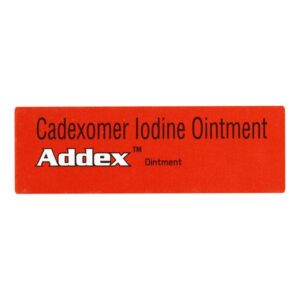POVIDONE IODINE + CADEXOMER IODINE
Povidone Iodine: Povidone Iodine is an antiseptic and disinfectant drug used to prevent and treat infections in wounds and skin.
Its mechanism of action involves the release of free iodine, which kills or prevents the growth of microorganisms such as bacteria, viruses, and fungi. Povidone Iodine works by interfering with the microbial enzyme systems, resulting in cell death and inhibition of their reproduction.
The drug can be administered topically and is available as a solution, ointment, or scrub. Topical solutions are typically diluted with water before use.
The dose and application of Povidone Iodine may vary depending on the type and severity of the infection. It is usually applied directly to the affected area using a cotton swab or dressing. It is recommended to consult a healthcare professional or follow the instructions on the product label for proper dosage and application.
As with any medication, Povidone Iodine can cause side effects. Common side effects include skin irritation, redness, itching, and a burning sensation. Some individuals may also experience an allergic reaction, which can be indicated by symptoms such as rash, hives, difficulty breathing, or swelling of the face, lips, tongue, or throat. If any severe allergic reactions occur, immediate medical attention should be sought.
Povidone Iodine should not be ingested or applied to large areas of broken skin or extensive burns, as it can lead to iodine toxicity. It is also not recommended for use on the eyes or in the genital area, as this can cause irritation or damage. Pregnant and breastfeeding women should consult their healthcare provider before using Povidone Iodine.
It is important to note that Povidone Iodine may interact with certain medications or other topical products, so it is advisable to inform the healthcare professional about any other drugs or treatments being used.
Cadexomer Iodine: Cadexomer Iodine is a medication used for wound management and is available as a topical gel or dressing. It contains iodine, which has antiseptic properties and aids in the healing process of infected wounds.
The mechanism of action of Cadexomer Iodine involves the slow release of iodine when it comes into contact with wound exudate. The iodine kills bacteria, fungi, and other pathogens present in the wound, reducing the risk of infection. It also helps to remove dead tissue and debris, aiding in wound debridement.
The recommended dose and application method of Cadexomer Iodine may vary depending on the severity of the wound and the healthcare professional’s instructions. Generally, the gel or dressing should be applied directly to the wound, ensuring it covers the entire area. It should be changed regularly, usually every one to three days, or as directed by a healthcare provider.
Common side effects of Cadexomer Iodine may include mild skin irritation, itching, or a burning sensation at the application site. These effects are usually temporary and tend to subside with continued use. However, if any severe or persistent side effects occur, it is important to seek medical attention.
Some individuals may be allergic to iodine, and using products containing iodine can cause an allergic reaction. It is essential to notify a healthcare professional of any known allergies or sensitivities before using Cadexomer Iodine.
Overall, Cadexomer Iodine is an effective tool for the management of infected wounds and assists in the healing process. However, it is important to follow healthcare professional instructions, monitor for possible side effects, and seek medical attention if necessary.

